(Continued from Part 2. This concludes the article.)
Johnny Come Lately
Two weeks after the scope arrived, and one week after the rings I ordered from Amazon arrived, a package was delivered from Leupold with the Quick Release Rings to match the Quick Release Mounts they had sent with the scope. They must have belatedly noticed their omission. I appreciated the gesture of sending the rings. Better late than never. But I was quite happy with the rings I had bought from Amazon, so I just left things well enough alone.
The Remington 742
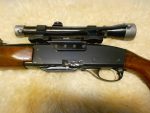 Next, I tuned up my Remington 742 for side by side testing with the BAR. The 742 is a gas-operated semiautomatic rifle produced by Remington from 1960 through 1980. The serial number on mine indicates that it was produced before 1967. The carbine model I own weighs 7.25 pounds, has a 18.5-inch barrel, and is chambered in 30-06. The 742 was also available in .243 Winchester, 6mm Remington, .280 Remington, and .308 Winchester.
Next, I tuned up my Remington 742 for side by side testing with the BAR. The 742 is a gas-operated semiautomatic rifle produced by Remington from 1960 through 1980. The serial number on mine indicates that it was produced before 1967. The carbine model I own weighs 7.25 pounds, has a 18.5-inch barrel, and is chambered in 30-06. The 742 was also available in .243 Winchester, 6mm Remington, .280 Remington, and .308 Winchester.
Although 10 and even 20 shot magazines are available for the 742, the larger magazines have a reputation for not feeding well, and the 742 has a reputation for becoming inaccurate when the barrel gets hot. The 742 is also known for wearing out the rails in the receiver after a relatively low round count. It is best used for occasional hunts, and not frequent use at the range.
My 742 is equipped with a vintage Weaver K2.5 60-B scope, a 2.5X scope introduced in 1956.
Laser Bore Sighters
As I mentioned above, the first laser bore sighter I ordered began to function erratically the second time I used it. It was the type that fits in the rifle chamber. I returned it and ordered a bore sighter that slides into the end of the barrel.
The second bore sighter I ordered did not point straight. If you twisted it in the barrel, you could see it rotate around the point of aim. I returned it as well.
If any SurvivalBlog reader has any advice about a reliable, reasonably priced laser bore sighter, I would love to hear it.
The Cheek Rest
 The combs on the buttstocks of both the BAR and the 742 seemed just a little too low for optimum use with a scope. I decided to try an experiment with the 742 to see if I could improve my cheek weld. I first cut a piece of heavy paper to fit the buttstock between the sling swivel and the grip. This was to protect the finish on the buttstock from the duct tape I was planning to use to secure a home-made cheek rest in place. I then fastened the paper in place with grey duct tape. Next, I cut some cardboard fillers and duct taped them to the top of the comb until I had raised it to a more optimum height. Finally, I taped over it all with brown duct tape to give it a (slightly) less unattractive appearance. It did not look very impressive, but it did give me a better cheek weld.
The combs on the buttstocks of both the BAR and the 742 seemed just a little too low for optimum use with a scope. I decided to try an experiment with the 742 to see if I could improve my cheek weld. I first cut a piece of heavy paper to fit the buttstock between the sling swivel and the grip. This was to protect the finish on the buttstock from the duct tape I was planning to use to secure a home-made cheek rest in place. I then fastened the paper in place with grey duct tape. Next, I cut some cardboard fillers and duct taped them to the top of the comb until I had raised it to a more optimum height. Finally, I taped over it all with brown duct tape to give it a (slightly) less unattractive appearance. It did not look very impressive, but it did give me a better cheek weld.
The First 742 Range Session
With the new cheek rest in place, I took the 742 to the range behind my garage.
![]() I began the session using a .30-06 to .30 U.S. M1 Carbine chamber adapter that I had purchased from MCA Sports in Anchorage, Alaska. The .30 Carbine loads produce almost no noticeable recoil in the 742, and are much less expensive and more comfortable to use than .30-06. I often use the adapter for some preliminary testing when I am using the 742.
I began the session using a .30-06 to .30 U.S. M1 Carbine chamber adapter that I had purchased from MCA Sports in Anchorage, Alaska. The .30 Carbine loads produce almost no noticeable recoil in the 742, and are much less expensive and more comfortable to use than .30-06. I often use the adapter for some preliminary testing when I am using the 742.
I put my baseball cap on backward before putting on my hearing protection, since the bill of my cap had gotten in the way at my last range session. The mosquitoes were, as usual, a bit of a distraction, but that is often a part of outdoor living.
I had previously used the chamber adapter in cold weather. I found out quickly that it works best cold. In warmer weather, it expands from the heat, and begins to become difficult to extract and reinsert into the chamber.
Murphy’s Law
During one difficult extraction, my right thumb came between the operating handle and the rear of the ejection port, peeling back a flap of skin on the tip of the thumb. It bled profusely. I went into the barn and improvised a bandage with part of a paper shop towel and some electrical tape. It bled through the bandage fairly quickly, so I replaced it with a second shop towel/electrical tape bandage part way through the range session. After the range session I went in the house, washed the wound with soap and water, treated it with hydrogen peroxide, dried it, and glued the flap back in place with super glue.
The .30 Carbine shots grouped well, so when the adapter became sufficiently difficult to chamber, I switched to .30-06. I used Golden Bear 145 grain FMJ. The first shot gave a hefty kick that quickly reminded me why I was interested in .243 Winchester.
The shots grouped well, and I was able to dial in the zero until the groups were clustered around the center of the target.
Since my range session with the BAR, I had sealed the larger sandbag better with a cable tie, and I had prepared a smaller sandbag for use under the bottom of the buttstock. The combination of the better sandbags and the better cheek weld seemed to improve my groups.
The results of a cheek rest on the 742 were good enough that I decided to try one on the BAR as well.
The Neoprene Cheek Rest
I ordered a Pridefend Neoprene Cheek Rest from Amazon. The cheek rest came with two sizes of foam inserts. I tried the smaller insert first, and found it to be too thick and too soft. I next tried pieces of corrugated cardboard cut to the right size. Three layers of cardboard seemed to give the best results.
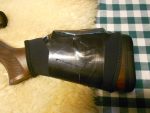 The problem was that the insert pocket was too large for the cardboard inserts, so I “bubba-ized” the sleeve by putting black duct tape around the outside to hold the cardboard firmly in place. I could just as well have used a piece of heavy paper under the duct tape like I did with the 742 rather than buying the neoprene sleeve. The neoprene sleeve did at least make the cheek rest fabrication process faster and somewhat less unattractive.
The problem was that the insert pocket was too large for the cardboard inserts, so I “bubba-ized” the sleeve by putting black duct tape around the outside to hold the cardboard firmly in place. I could just as well have used a piece of heavy paper under the duct tape like I did with the 742 rather than buying the neoprene sleeve. The neoprene sleeve did at least make the cheek rest fabrication process faster and somewhat less unattractive.
The Next Range Session
The improved cheek weld made possible by the cheek rest made my groups much tighter. I did notice again that the barrel warmed quickly, and that the groups enlarged somewhat as the barrel warmed.
With cheek rests on both the 742 and the BAR, I was now ready to test the two rifles side by side.
BAR Versus Model 742
I spread out an old army blanket under a tree at the edge of my range, and laid out the guns and range bag on it. I thought that shooting from a seated position would more closely approximate typical deer hunting conditions than firing from a bench rest. As I sat down, I noted that the blanket was on enough of a slope that I tended to slide down hill. I folded back the blanket, took a trowel, and leveled off the area under my seat.
After replacing the blanket and again taking a seat, I fired three 4 shot groups each from the BAR and 742 in the following order: BAR, 742, 742, BAR, BAR, 742. In the BAR, I was using PPU Rifleline SP 100 grain. In the 742, I was using Winchester Super X 180 grain Power Point.
The BAR delivered the two tightest groups, although all of the groups from both rifles were satisfactory “minute of a deer’s vitals” shots. For some reason, the BAR groups were centered about 1.5 inches low. This was not the case for the 742.
It was immediately apparent that the .30-06 is a much more powerful round than the .243, as it kicked up large clouds of dust from the backstop in addition to the kick it was giving my shoulder.
It was also immediately apparent that the BAR was much more pleasant to shoot than the 742. I would be much more likely to train regularly with the BAR than I would with the 742. This, in turn, would be expected to increase my proficiency in the field.
Buffalo Bore Ammo Test
The next day, I took the BAR out to the range again to test it with some Buffalo Bore ammo. The three different types of loads I tested were their 43C, 43E and 43F.
The 43C uses a 70 grain Nosler Ballistic Tip bullet. It reportedly moves at 3,650 feet per second out of a 26 inch barrel, and generates 2,070 foot-pounds of muzzle energy. The bullet tends to fragment explosively at ranges of under 150 yards or so, leaving large exit wounds in varmints. This makes it highly effective at putting varmints down, but undesirable if you want to save the hide. This particular load utilized Federal cases, while the other two loads utilized Winchester cases.
The 43 E uses an 85 grain Barnes TSX Boat Tail bullet, which is all copper. It reportedly moves at 3,350 feet per second out of a 26 inch barrel, and generates 2,118 foot pounds of muzzle energy. The controlled expansion of the TSX bullet provides enough penetration for taking larger animals like deer, while not ruining the pelt of smaller animals like foxes or coyotes as long as the bullet does not strike bone.
The 43F uses a 100 grain Sierra Spitzer Flat Base bullet. It reportedly moves at 3,150 feet per second out of a 26-inch barrel, and generates 2,203 foot pound of muzzle energy. The bullet may fragment at shorter ranges, especially if it hits bone. This fragmentation may reduce its penetration in larger animals.
All three types of ammo functioned extremely well in the BAR, feeding reliably and delivering good accuracy as long as I did my part. I was surprised to note that I seemed to get slightly better accuracy from the less expensive PPU ammunition that I had used in the preliminary testing.
Conclusions
 The Browning Autoloading Rifle in .243 Winchester is an attractive, reliable, soft recoiling and versatile hunting rifle. It is impressively accurate from a cold bore, and acceptably accurate after it gets hot. It is a bit on the pricey side, with a manufacturer suggested retail price of $1,299. For those who can afford it, it would be a great choice as a deer rifle for younger, smaller, or older hunters, or anyone else who would prefer a little less recoil than some other options produce.
The Browning Autoloading Rifle in .243 Winchester is an attractive, reliable, soft recoiling and versatile hunting rifle. It is impressively accurate from a cold bore, and acceptably accurate after it gets hot. It is a bit on the pricey side, with a manufacturer suggested retail price of $1,299. For those who can afford it, it would be a great choice as a deer rifle for younger, smaller, or older hunters, or anyone else who would prefer a little less recoil than some other options produce.
Disclaimer
Browning was kind enough to loan me the BAR Mk3 in .243 for testing and evaluation. Buffalo Bore Ammunition provided 40 rounds each of three different cartridges for testing. Leupold loaned me a scope and rings for testing. I tried not to let the kindness of these vendors influence my evaluations of their products. I believe that I succeeded in drawing objective conclusions.

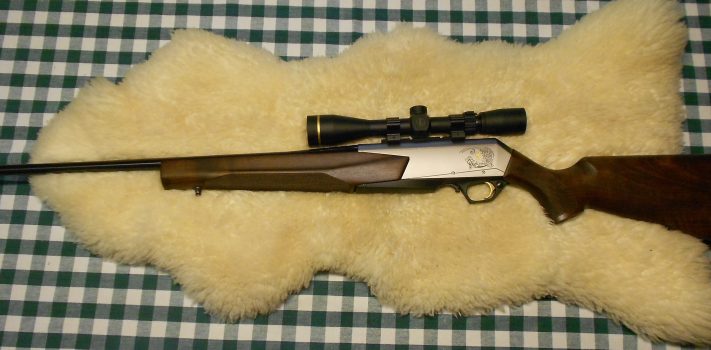










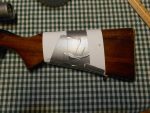
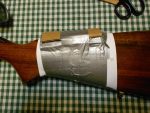
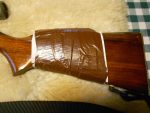
Regarding bore sighters, I believe their purpose is to get shots on paper, and then the shooter fine tunes from there. If the bore sighter is not perfect, it shouldn’t be too big of a deal.
With that being said, I’ve found the laser bore sighting device that actually fits in the firearm chamber to be the most accurate. Sightmark and EZshoot are two brands of that I’m aware, and they’re both available on Amazon.
Jackalope, thank you for the input.
sitelite is the best I have ever found. I have the high power green one. You can use it at 200 yards in daylight against a white background.
I never tire of firearm reviews. I believe this is an outstanding review and will give anyone a blueprint for selecting a semi-automatic rifle.
I’m somewhat familiar with semi-automatic rifles and have picked up several pointers from this review.
Great review! Thank you for a great effort.
Hi Francis, Thanks for the encouraging word.
Enjoyed your review, I would encourage others to purchase a PAST mag recoil pad, if recoil is an issue.
https://www.midwayusa.com/product/100251390?pid=367156
Might keep you shooting that favorite old gun.
Ozark Redneck, you are way ahead of me. I thought the BAR was a little pricey, so I am currently testing a recoil pad.
Although the Remington 742, and the latter version, the 7400, are handy and softer recoiling, my two examples were disappointing. The magazine is usually the source of the jamming problems. And because these rifles are not easy to disassembly and clean, used rifles often suffer from a lack of maintenance. If one cannot step up to the Browning, I’d stick with a bolt gun. As someone who once developed a flinch from shooting 12ga too often, I stuck with the 6.5 x 55 in a Swedish Mauser for a while until my flinch disappeared. Of course I’d like to have that Browning! Thanks for the article. I can dream. Even if one was a bit recoil sensitive, this rifle could be reliable enough to be good for dangerous game. A fast follow up shot on a Griz shoulder might be possible with this rifle.
Tunnel Rabbit, thanks for the input. I agree that if you don’t already own a 742, I would not recommend buying one. A bolt gun would be an excellent choice. The BAR was a bit pricey, so I am currently testing a recoil pad. If that doesn’t help, I plan to test a bolt gun next.
Nice mod for that gun. My uncle used to have a nice Remington 742 and it was my favorite. Too bad it was destroyed after the Jeep accident. He prioritized rebuilding the Wrangler and we’re going to install the new set of tires from 4Wheelonline this week. Next is hunt for a new Remington 742.